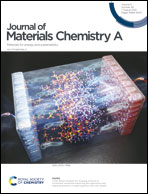Toward efficient perovskite solar cells by planar imprint for improved perovskite film quality and granted bifunctional barrier†
Abstract
Polycrystalline perovskite films generally have high-density defects due to the numerous crystal nuclei and randomly oriented fine grains in the film formation. These defects are commonly regarded as the source of non-radiative recombination, which seriously damages the photovoltaic performance of perovskite solar cells (PSCs). Therefore, ideal perovskite films with a suitable grain size and preferred orientation are significant for PSCs. In this paper, an effective planar imprint (PiP) method was applied to promote perovskite film recrystallization. The formation process of a superior perovskite grain was revealed by analyzing the morphology and the mechanical simulation results. Meanwhile, trimethoxy (1H,1H,2H,2H-heptadecafluorodecyl) silane (FAS) oligomers were introduced as a bifunctional barrier to passivate the defects and protect the perovskite film through the PiP process. Ultimately, the improved film quality enabled a significant improvement in power conversion efficiency (PCE) and superior stability. In comparison with the PCE of 18.35% for the pristine device, the champion PCE of the PiP treated device achieved 20.52%. In addition, there was almost no obvious degradation in the PiP treated film after 35 days of being stored in air with ≈60% humidity at 25 °C.



 Please wait while we load your content...
Please wait while we load your content...